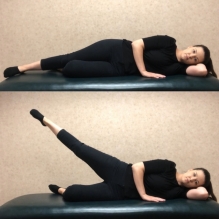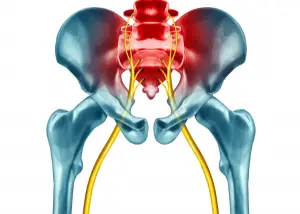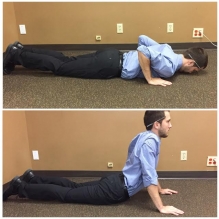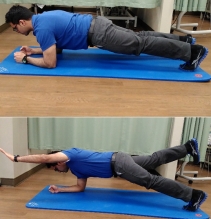A total hip replacement is a surgical procedure in which the diseased cartilage and bone are removed from the affected joint, then replaced with artificial materials. It’s usually done to relieve arthritis pain or, in some instances, after a severe trauma with fracture or dislocation.
Each year there are over 200,000 Total hip replacements and nearly 100,000 partial hip replacements performed. Most hip replacements are successful, and the prosthetic can last for more than 20 years. However, in some unfortunate instances, patients can have a new onset or worsening symptoms of Sciatica after surgery.
This article will explore total hip replacements and Sciatica – what it is, what causes it, how common it is post total hip replacement surgery, and exercises to help with Sciatica after total hip replacement surgery.
Can a Hip Replacement Surgery Cause Sciatica
Yes, a total hip replacement can cause Sciatica. There are two leading causes: injury to the Sciatic nerve during surgery or irritation of the Sciatic after surgery as you compensate to protect the new surgical joint. This is most noticeable when you are limping after surgery which can cause more stress on the back.

Causes of Sciatica Post Hip Replacement
There two most common causes of Sciatica after a hip replacement are injuries sustained during surgery, which we’ll review shortly, and injury to the Sciatic nerve from compensations in recovery. This can be due to limping, weakness, swelling, and even sitting too much.
Sciatica Injury From Hip Surgery
The first cause of Sciatica after a hip replacement is direct trauma to the nerve during surgery. Hip replacement surgeries are the second most common cause of Sciatic nerve injury from a medical procedure, behind only Gluteal injections. In a literature review, the frequency of Sciatic nerve injury from a hip replacement ranges from 0.17% to 7.6%.
During surgery, there are several reasons the sciatic nerve can be damaged. This includes trauma from surgical instruments, nerve compression by clips, increased pressure on the nerve from blood and fluids, decreased blood flow to the area, or placing the leg and nerve in compromising positions.

In many cases, any diagnostic test cannot determine the exact cause of nerve injury during surgery. Some of the injuries sustained during surgery may take quite a while to heal.
Compensations After Hip Surgery that Contribute to Sciatica
The second leading cause of Sciatica after a hip replacement is compensating for the surgery, which can irritate the nerve. Most people who reach the age where they have to have a hip replacement also likely have arthritis in their lumbar spine.
When you have surgery, arthritis in the back may not tolerate the changes in walking and muscle tightness, aggravating pre-existing arthritis and Sciatic nerve.
We’ll cover the other compensations to watch out for after hip surgery in the coming sections.
Changes in Walking Mechanics After Hip Surgery
After hip surgery, you’ll be walking quite differently than you were before surgery. You’ll be limping because of the pain and using a walker to take pressure off the hip.
Limping with a trunk lean to the side to offload the newly reconstructed hip can put new pressure on the sciatic nerve where it exits the spine.

To fix this, try and put as much as you can through the walker or cane when you’re walking. Also, the more upright and neutral you can keep your back, the less likely you are to flare up the nerve.
Pro Tip: Film yourself or have your therapist film your gait after surgery. You’ll be surprised at the changes, and it’s easier to fix once you see them.
Tight Muscles After Hip Surgery
After surgery, you may have some tightness in your hip that affects sciatic nerve function. The muscles in the deep parts of the hip can be swollen and tight in the aftermath of surgery.
This increased tightness can sometimes put pressure on the Sciatic nerve and cause radicular pain down the leg. These issues typically resolve quickly with stretching and exercises to loosen the muscles and reduce stress on the nerve.
Weakness in the Hip Post Surgery
Weakness in the muscles that help control hip stability can also affect sciatic nerve function after surgery. The muscles are weak for multiple reasons, including being cut during surgery, increased swelling in the area, and pain.
Pain and swelling don’t allow the muscles to tighten and activate fully, which results in weakness in the hip. That weakness cause compensations and limping in the surgical hip and, at times, can put pressure on the Sciatic nerve.

This issue typically resolves itself quickly as the muscles of the hip increase their strength.
Related Topic: 6 Ways to Speed up Recovery After A Hip Replacement
Sitting Too Long Can Cause Sciatica
Sitting too much can cause Sciatica. Sitting and being inactive after is ok for short periods to allow for healing to happen. However, sitting in one place for too long can cause the nerve to become irritated.
Set a timer on your phone and get up and walk for 5 minutes at the minimum around the house to fix this. This helps take the pressure off the nerve if that’s the cause.
If you are sitting for periods of time long enough to give you Sciatica that’s a warning sign that you need to be up moving more in order to have a successful recovery from hip surgery.
Can Needing a Hip Replacement Cause Sciatica?
Yes! The Sciatic nerve can be irritated by needing a total hip replacement. When you have end-stage hip arthritis, you tend to lean forward and avoid extending your hip behind you.
These compensations put a lot of stress on your back. There is also a good chance you are limping and that the hip is getting weaker by the day. The longer this goes on, the more likely it can cause issues in the back and other joints such as the knee or ankle.
The best way to get rid of Sciatica with end-stage hip arthritis and needing a hip replacement is to get it fixed with surgery and have a hip replacement.
How to Get Rid of Sciatica After a Hip Replacement
Treating Sciatica after a hip replacement can be challenging because you are also recovering from surgery for the new hip. You still have to avoid certain positions and muscles that you are not allowed to stretch yet safely.
We’ve provided 4 ways to help treat Sciatica when it occurs after a hip replacement.
Perform Sciatic Nerve Glides in Sitting
Performing sciatic nerve glides is the easiest way to help your sciatica nerve calm down after surgery quickly. The sciatic nerve glides are specific exercises that help stretch the nerve and glide it through the nerve pathway. This helps bring blood to the area and enables it from being compressed in one place.

After a hip replacement, the best way to do this exercise is to sit down with your legs straight out in front of you. From here, straighten your knee and pull your toes toward your shin and hold for 5 seconds. Next, point your toes away for 5 seconds and repeat.
Related Topic: You can see our favorite nerve glides in this post here.
Stay Active and Walk Often
Being inactive after surgery can cause Sciatica to occur. The sciatic nerve needs movement and activity for it to heal correctly and avoid compression.
To keep the Sciatica from flaring up during your recovery, set a timer on your phone or alarm clock and get up and walk around for five minutes every hour while you’re awake, even if you’re resting.
Another option is to use an exercise bike to stay active after a hip replacement. This also includes using a recumbent elliptical, one of the best exercise machines to use after a hip surgery.
Relate Topic: See our Best Exercise Machines After a Hip Replacement Here
Perform Sciatic Specific Back Exercises That are Safe For Your Hip
Seated Hip Abduction
Perform a seated hip abduction by sitting on the edge of a chair with your legs straight. Keeping your back straight, lift one leg off the floor and squeeze for five seconds at 15 repetitions per side (30 total).
Prone Press-ups
Lower yourself down to the ground and avoid pushing all of your weight onto your toes from a push-up position. Ensure that you keep your core tight and drive through the hands rather than out through the feet.

Hip Hinge Low Back Stretch
This low back stretch is very effective in helping Sciatica by releasing tension on the lower back, opening up the nerve root, and reducing compression on the nerve.
Stand at the kitchen counter or near a railing and hold on with your hands. Send your hips as far back as you can while still holding on with your hands.
You may have to bend your knees to take the tightness out of your legs and transfer it to your low back. Hold this for 15-30 seconds and repeat.
Related Topics: See our Best Back Stretchers to Help with Sciatica
Try a Hot Pack to Calm Down the Nerve
Heat therapy is excellent for Sciatica because it helps to decrease the nerve’s sensitivity and increase blood flow. Heat therapy also reduces muscle tension which is excellent for Sciatica. The less passive pressure on the muscles, the less compression overall that there is on the nerve.
Get a microwaveable hot pack and heat it. Place on the low back just above the belt-like for 15-20 minutes at a time. We especially love to use hot packs right before bed or first thing in the morning to get the localized blood flow going.
Tips For Decreasing the Risk of Developing Sciatica After Hip Surgery
If you currently have or have previously had Sciatica and are worried about it returning after a hip replacement, then there are some tips you have can work on before surgery to decrease your risk.
Strengthen Your Core
A common issue with Sciatica is having weak core muscles. Our spine works like a chain with each vertebrae supporting the next one down, if one link in that chain is damaged, then your entire lower back can be affected and eventually lead to Sciatic pain.

So make sure you work on strengthening your core to decrease Sciatica before, during, and after surgery.
Improve your Hip Strength and Stability
Having weak hips can also increase the risk of developing Sciatica.
This is especially true after a hip replacement because your hip muscles are weakened from surgery.
Our best advice? Work on your hip strength well before you have surgery. If you can use the 3 months before surgery to build up strength, you can decrease your risk of developing issues afterward.
Exercise Daily
Another step to decrease the risk of developing Sciatica after surgery is creating an exercise routine.
By exercising daily for 30 minutes or more, you’ll build up your cardiac system, improve your lung health, build up muscle, and improve your muscular endurance to help you recover faster after surgery. This builds up your body and makes it more resilient to issues such as Sciatica.
One of our favorite ways to exercise with an arthritic hip is to use a recumbent elliptical. It’s low weight-bearing, works all the right muscles, and is comfortable to use with arthritis.
Lose Weight Before Surgery
The more weight you can lose before surgery, the better your back will be after surgery. For every 1 pound that you lose, it’s a reduction in 4 pounds of pressure off your spine. Just imagine what losing 10 pounds would do to your spine health?
That’s the equivalent of losing 40 pounds of force off your spine.
A combination of exercise, diet modifications, and portion control can go a long way to helping your back survive a total hip replacement.
Related Topic: Best Treadmill for Low Back Pain
Conclusion:
Sciatica can be a common side effect after a total hip replacement. In some instances, it is caused by an injury to the nerve during surgery, and in other cases, it’s caused by compensations and imbalances in the body that occur during recovery.
Either way, there are ways to decrease Sciatica after surgery and ways that you can reduce the risk of developing Sciatica before you even have surgery.
GLP Weight Loss and Back Health: Effective Strategies and Insights
How to Stay Active After Cervical Fractures: Expert Tips and Advice
Dealing with Painful Stairs After Ankle Replacement Surgery
Walking After a Total Ankle Replacement: Tips for a Successful Recovery
Exercises While Non-Weight Bearing After Ankle Replacement: Elevation, AROM, Leg Raises, and More
Ankle Pain with Stairs: Causes and Home Treatment Options
Disclaimer: The information provided in this post is for educational purposes only. This is not a substitute for a medical appointment. Please refer to your physician before starting any exercise program.






